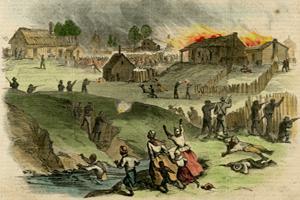On May 1-2, 1866, Memphis, Tennessee, suffered the worst racial conflict in its history, now known as the Memphis Massacre. Forty-six Blacks and two Whites died during those two days, with many more injured and scores of houses, churches and schools destroyed by fire. The ensuing Congressional investigation led to a report that helped pass the Fourteenth Amendment of the Constitution making all ex-slaves citizens of the United States.
-

Memphis Massacre, 1866: "Harper's Weekly", May 26, 1866
One of the most widely-read newspapers in the United States at the time, the New York-based "Harper's Weekly" published an account of what happened in Memphis earlier in the month in its May 26, 1866, issue which was a more dispassionate report on the Memphis Massacre than most other newspapers ran. The article also featured illustrations which are the only contemporary images we have of the violence.
-

Memphis Massacre, 1866: Introduction to "The Reports of the Committees..."
A short introduction of the background of the Memphis Massacre of 1866 which prompted a U.S. Congressional committee to visit Memphis soon after to gather testimony and report back to Congress.
-

Memphis Massacre, 1866: "Reports of the Committees of the House of Representatives...1865-'66". Report and testimony
"The Reports of the Committees of the House of Representatives Made During the First Session, Thirty-ninth Congress,1865-'66", Washington: Government Printing Office, 1866. The complete report, with testimony, of the Congressional select committee which investigated the events of the Memphis massacre in Memphis, Tennessee, of May 1866.


